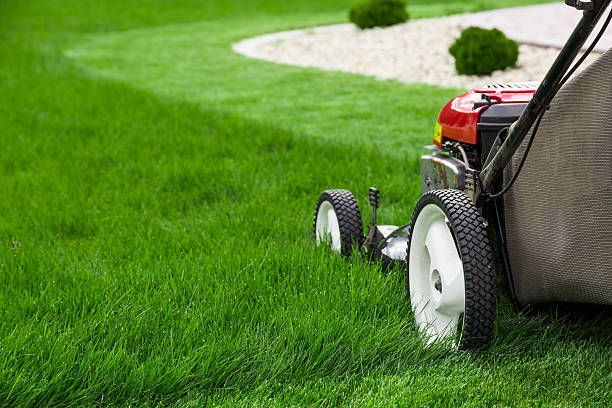Taking care of a lawn seems simple. You water it, mow it, maybe throw down some fertilizer, and that’s it, right? Not exactly. A lot of people follow lawn care advice that doesn’t actually work—or worse, makes things harder than they need to be.
If you’ve ever wondered why your grass still looks patchy or why weeds keep coming back no matter what you do, you might be making one of these common mistakes.
Watering Too Often—or Not Enough
One of the biggest mistakes people make is how they water their lawn. Some people water every day, thinking more water equals healthier grass. Others wait until their lawn looks dry before soaking it. Neither of these methods is great.
Grass doesn’t need to be watered every day. In fact, watering too often can make the roots weak because they don’t have to grow deep to find moisture. On the other hand, waiting too long and then flooding your lawn doesn’t help either. The best way to water? Less often, but more deeply. Two to three times a week is usually enough, depending on the weather.
Cutting the Grass Too Short
A lot of people mow their lawns as short as possible, thinking they won’t have to mow again for a while. But cutting grass too short actually weakens it. Short grass struggles to grow strong roots and is more likely to dry out or get taken over by weeds.
A good rule of thumb is to never cut off more than one-third of the grass height at a time. Keeping your lawn a little longer helps it stay healthier and prevents problems like bare patches.
Ignoring the Type of Grass You Have
Not all grass is the same. Some types grow well in hot, dry weather, while others need a cooler, wetter climate. If you’re treating your lawn the same way as someone who lives in a completely different environment, it might not work.
Knowing what kind of grass you have makes a huge difference. It helps you figure out how much water it needs, how often to mow, and what kind of fertilizer will actually help it grow.
Mowing with Dull Blades
Dull mower blades tear the grass instead of cutting it cleanly. This makes the grass look ragged and can even make it more prone to disease. If your lawn looks uneven or frayed after mowing, the problem might not be the grass—it could be your mower blades.
Sharpening your mower blades a couple of times a season can keep your lawn looking neat and healthy. If you need better equipment to get the job done efficiently, Ride On Mowers Perth can make maintaining a large yard a whole lot easier.
Using the Wrong Fertilizer—or Too Much of It
Fertilizer can help your grass grow thick and green, but only if you use the right kind. Some people grab whatever fertilizer is on sale, not realizing different types do different things. Others think more fertilizer is always better, but too much can actually burn the grass and make it turn yellow.
The key is finding the right fertilizer for your lawn and applying it at the right time. A slow-release fertilizer is usually best because it feeds your grass over time instead of all at once.
Not Dealing with Weeds the Right Way
Pulling out weeds by hand might seem like a good idea, but it’s not always effective. Some weeds, like dandelions, have deep roots. If you don’t get the whole thing out, it just grows back.
The best way to prevent weeds is to have thick, healthy grass. Weeds love bare spots, so the stronger your lawn is, the less space weeds have to grow. If you already have a weed problem, using the right type of weed killer or applying mulch in garden areas can help.
Forgetting About Lawn Aeration
A lot of people don’t even think about aerating their lawn, but it can make a huge difference. Over time, the soil gets compacted, which makes it harder for water, air, and nutrients to reach the roots.
Aeration is just the process of poking small holes in the lawn to loosen up the soil. It helps grass grow better and absorb water more efficiently. If your lawn is looking lifeless even though you’re doing everything right, it might just need some aeration.
Not Adjusting for the Seasons
Grass needs different care depending on the time of year. In the summer, it needs more water, while in the fall, it benefits from extra nutrients to prepare for winter. A lot of people treat their lawn the same way year-round, which can lead to problems.
If you live in a place with cold winters, fall is a great time to fertilize and aerate. If your area gets hot summers, watering deeply and mowing a little higher can help keep your grass from drying out.
Expecting Instant Results
Lawn care takes time. Some people try one thing and, when they don’t see immediate results, they give up or switch to another method. But grass doesn’t grow overnight. If you’re trying to fix a patchy or unhealthy lawn, it might take weeks or even months to see big improvements.
The key is to be consistent. Water the right way, mow properly, and give your lawn what it needs, and you’ll start seeing results before you know it.
Keeping Lawn Care Simple
A lot of people overcomplicate lawn maintenance, but it doesn’t have to be difficult. Watering correctly, mowing at the right height, using the right fertilizer, and keeping up with small tasks like aeration can make a big difference.
Instead of spending time fixing problems, taking care of your lawn the right way from the start can save you time and effort in the long run. Keep it simple, and your grass will thank you.
